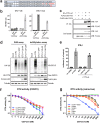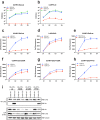Stable Occupancy of the Crimean-Congo Hemorrhagic Fever Virus-Encoded Deubiquitinase Blocks Viral Infection
- PMID: 31337717
- PMCID: PMC6650548
- DOI: 10.1128/mBio.01065-19
Stable Occupancy of the Crimean-Congo Hemorrhagic Fever Virus-Encoded Deubiquitinase Blocks Viral Infection
Abstract
Crimean-Congo hemorrhagic fever virus (CCHFV) infection can result in a severe hemorrhagic syndrome for which there are no antiviral interventions available to date. Certain RNA viruses, such as CCHFV, encode cysteine proteases of the ovarian tumor (OTU) family that antagonize interferon (IFN) production by deconjugating ubiquitin (Ub). The OTU of CCHFV, a negative-strand RNA virus, is dispensable for replication of the viral genome, despite being part of the large viral RNA polymerase. Here, we show that mutations that prevent binding of the OTU to cellular ubiquitin are required for the generation of recombinant CCHFV containing a mutated catalytic cysteine. Similarly, the high-affinity binding of a synthetic ubiquitin variant (UbV-CC4) to CCHFV OTU strongly inhibits viral growth. UbV-CC4 inhibits CCHFV infection even in the absence of intact IFN signaling, suggesting that its antiviral activity is not due to blocking the OTU's immunosuppressive function. Instead, the prolonged occupancy of the OTU with UbV-CC4 directly targets viral replication by interfering with CCHFV RNA synthesis. Together, our data provide mechanistic details supporting the development of antivirals targeting viral OTUs.IMPORTANCE Crimean-Congo hemorrhagic fever virus is an important human pathogen with a wide global distribution for which no therapeutic interventions are available. CCHFV encodes a cysteine protease belonging to the ovarian tumor (OTU) family which is involved in host immune suppression. Here we demonstrate that artificially prolonged binding of the OTU to a substrate inhibits virus infection. This provides novel insights into CCHFV OTU function during the viral replicative cycle and highlights the OTU as a potential antiviral target.
Keywords: Nairoviridae; RNA replication; antiviral agents; bunyavirus; innate immunity; interferon-stimulated gene-15; proteases; ubiquitination.
Figures






Similar articles
-
Independent inhibition of the polymerase and deubiquitinase activities of the Crimean-Congo Hemorrhagic Fever Virus full-length L-protein.PLoS Negl Trop Dis. 2020 Jun 4;14(6):e0008283. doi: 10.1371/journal.pntd.0008283. eCollection 2020 Jun. PLoS Negl Trop Dis. 2020. PMID: 32497085 Free PMC article.
-
Crimean-Congo Hemorrhagic Fever Virus Suppresses Innate Immune Responses via a Ubiquitin and ISG15 Specific Protease.Cell Rep. 2017 Sep 5;20(10):2396-2407. doi: 10.1016/j.celrep.2017.08.040. Cell Rep. 2017. PMID: 28877473 Free PMC article.
-
ISG15 overexpression compensates the defect of Crimean-Congo hemorrhagic fever virus polymerase bearing a protease-inactive ovarian tumor domain.PLoS Negl Trop Dis. 2020 Sep 15;14(9):e0008610. doi: 10.1371/journal.pntd.0008610. eCollection 2020 Sep. PLoS Negl Trop Dis. 2020. PMID: 32931521 Free PMC article.
-
Crimean-Congo Hemorrhagic Fever: Tick-Host-Virus Interactions.Front Cell Infect Microbiol. 2017 May 26;7:213. doi: 10.3389/fcimb.2017.00213. eCollection 2017. Front Cell Infect Microbiol. 2017. PMID: 28603698 Free PMC article. Review.
-
The Role of Nucleocapsid Protein (NP) in the Immunology of Crimean-Congo Hemorrhagic Fever Virus (CCHFV).Viruses. 2024 Sep 30;16(10):1547. doi: 10.3390/v16101547. Viruses. 2024. PMID: 39459881 Free PMC article. Review.
Cited by
-
Characteristics of viral ovarian tumor domain protease from two emerging orthonairoviruses and identification of Yezo virus human infections in northeastern China as early as 2012.J Virol. 2025 Feb 25;99(2):e0172724. doi: 10.1128/jvi.01727-24. Epub 2024 Dec 31. J Virol. 2025. PMID: 39745436 Free PMC article.
-
Host Cell Restriction Factors of Bunyaviruses and Viral Countermeasures.Viruses. 2021 Apr 28;13(5):784. doi: 10.3390/v13050784. Viruses. 2021. PMID: 33925004 Free PMC article. Review.
-
HERC5 and the ISGylation Pathway: Critical Modulators of the Antiviral Immune Response.Viruses. 2021 Jun 9;13(6):1102. doi: 10.3390/v13061102. Viruses. 2021. PMID: 34207696 Free PMC article. Review.
-
Innate immune response against vector-borne bunyavirus infection and viral countermeasures.Front Cell Infect Microbiol. 2024 Apr 22;14:1365221. doi: 10.3389/fcimb.2024.1365221. eCollection 2024. Front Cell Infect Microbiol. 2024. PMID: 38711929 Free PMC article. Review.
-
Independent inhibition of the polymerase and deubiquitinase activities of the Crimean-Congo Hemorrhagic Fever Virus full-length L-protein.PLoS Negl Trop Dis. 2020 Jun 4;14(6):e0008283. doi: 10.1371/journal.pntd.0008283. eCollection 2020 Jun. PLoS Negl Trop Dis. 2020. PMID: 32497085 Free PMC article.
References
-
- García Rada A. 2016. First outbreak of Crimean-Congo haemorrhagic fever in Western Europe kills one man in Spain. BMJ 4891:i4891. - PubMed
-
- Negredo A, de la Calle-Prieto F, Palencia-Herrejón E, Mora-Rillo M, Astray-Mochales J, Sánchez-Seco MP, Bermejo Lopez E, Menárguez J, Fernández-Cruz A, Sánchez-Artola B, Keough-Delgado E, Ramírez de Arellano E, Lasala F, Milla J, Fraile JL, Ordobás Gavín M, Martinez de la Gándara A, López Perez L, Diaz-Diaz D, López-García MA, Delgado-Jimenez P, Martín-Quirós A, Trigo E, Figueira JC, Manzanares J, Rodriguez-Baena E, Garcia-Comas L, Rodríguez-Fraga O, García-Arenzana N, Fernández-Díaz MV, Cornejo VM, Emmerich P, Schmidt-Chanasit J, Arribas JR. 2017. Autochthonous Crimean-Congo hemorrhagic fever in Spain. N Engl J Med 377:154–161. doi:10.1056/NEJMoa1615162. - DOI - PubMed
Publication types
MeSH terms
Substances
Grants and funding
LinkOut - more resources
Full Text Sources
Molecular Biology Databases
Miscellaneous

